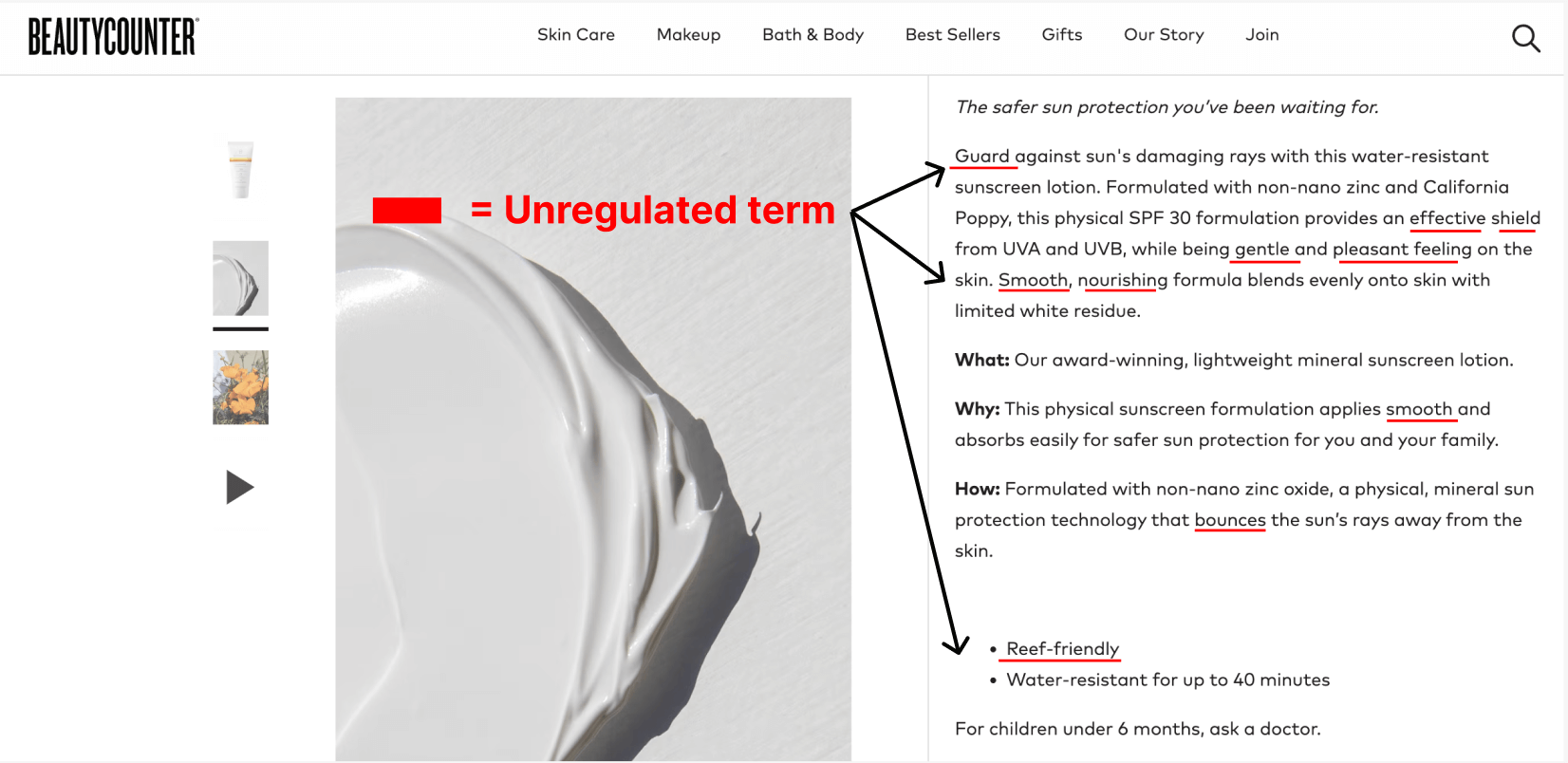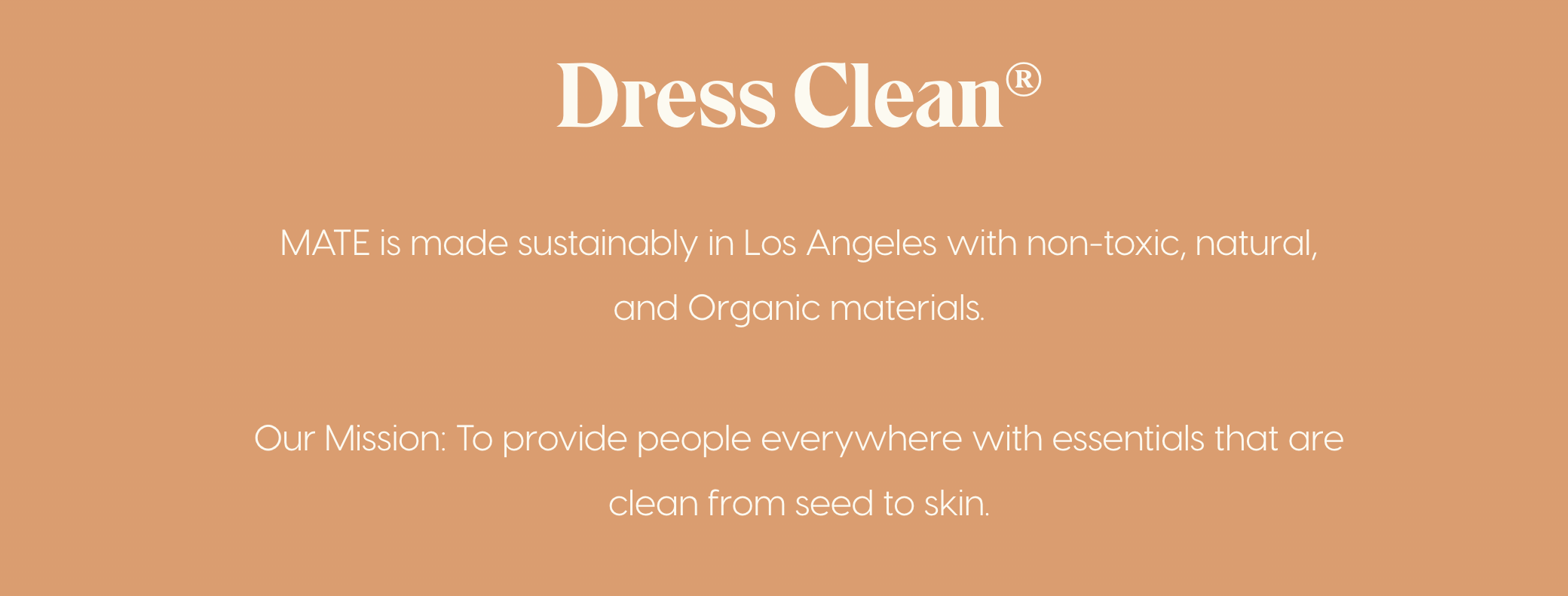I used to work with a skincare brand that sold sunscreen.
The brand claims that their sunscreen is “reef safe” and often touts the “sustainable” aspects of their products.
While those words sound good, there’s just one problem: they’re not true.
Like much of the copy you see in marketing, the terms “sustainable” and “reef safe” are unregulated, which means there is no legal criteria a brand must prove in order to use them.
Further, there is no scientific evidence proving that sunscreen of any kind is safe or non-toxic to coral reefs and other marine life (but there’s plenty of evidence to the contrary and legal precedence against using this type of terminology).
This is just one example of the many ways brands – and yes, copywriters – can give consumers false hope (and a false sense of security) when it comes to buying products.

This fact has always bothered me, but I’ve always felt caught in the middle between wanting to tell the truth and needing to earn a living.
Sure, I’ve turned down projects that are clearly shady and don’t align with my values, but sometimes spotting “the bad guys” isn’t so obvious – especially when you don’t have experience or you don’t “see it” until you’re months in and under contract.
This doesn’t mean “all brands are bad” – quite the contrary. I’ve worked with plenty of clients who have high levels of integrity and ethical standards that extend to their products and marketing.
But there will always be brands that will bend the truth for a buck, which is why in today’s article, I’m sharing some tips that may help you avoid getting duped by misleading marketing.
This article is not about boycotting or canceling brands – it’s about arming yourself with the tools you need to see the whole picture – not just the “sunny side” presented to you through the copy or advertising.
Alright, let’s get into it!
#1: Do your own research
Whether it’s a marketing claim or a news article, my default mode is always “healthy skepticism,” meaning I’m unlikely to believe it’s true until I do a little research.
This can be as simple as doing a quick Google search to check the validity of a source or claim, or reading through reviews to see if real customers are backing up what the brand is saying.
I may check competing products (or competing news sources). I may browse through forums – like Reddit or Quora – to see what people are saying. Or I may read through reports and scientific papers to see what experts have found.
It doesn’t have to take hours, but spending a few minutes of your time to make sure you’re getting the facts can be helpful.
#2: Look for opposing claims, views, or evidence
A copywriter’s job is to highlight the benefits and positives of a product while downplaying (or in some cases, ignoring) the downsides.
For this reason, you’ll want to look for opposing views or evidence that goes against whatever the brand is claiming to make sure you’re considering all sides before making a decision.
Even products that appear totally benign – like charitable foundations, renewable energy, biodegradable products, sustainable fashion, and organic foods – are worth looking into fully to make sure you’re not being deceived.

It doesn’t mean you’ll always find something during your investigations, but at least you’ll know you considered all sides (and did your homework) before making a decision.
#3: Ask for proof if you don’t see it
If a brand is making bold claims like “erases fine lines in 30 days” or “increases hair growth by 75%” and you don’t see any mention of research studies or clinical trials backing up those claims, ask for proof.
If the brand doesn’t respond (or responds with something like “we’re working on it!”), you have your answer.
#4: If proof is provided, don’t just accept it – look under the hood
If the brand provides you with proof in the form of a clinical trial or study, here are some questions you should ask yourself when evaluating the legitimacy:
Who funded the research
Was the trial or study conducted by an independent research firm or was it funded by the company making the claim? Looking into who conducted a study (and why) can help you see if there may be potential biases in the method or results.
The # of trials or studies
Was it a single trial/study or have multiple and/or independent studies/trials been conducted? The more studies showing similar evidence, the better.
The # of participants / sample size
Was it a sample size of 20 or a trial of 2,000 people? The bigger the sample size, the more confidence you can have in the overall findings.
Type of evidence
If multiple trials or studies have been conducted, what were the overall findings? Are they conclusive, at odds with each other, or mixed? If you’re seeing competing evidence, the claims may be deceptive.
And don’t just look at one of the categories above; like customer research, a more reliable theory or conclusion involves combining multiple methodologies and evidence, not cherry picking.

#5: Beware of unregulated or misleading words
When it comes to certain products – particularly those in the beauty, retail, wellness, and food industries – there are certain words you can’t use for legal reasons.
To work around regulations, marketers – and yes, copywriters – have to rely on unregulated words to describe products and the results they promise, or come up with new ways to describe them that won’t result in a lawsuit.
This is why you often see clothing brands using words like “clean” instead of “fabrics do not contain any harmful chemicals” or beauty brands using words like “plump” instead of “increases collagen by 33%!”

They can’t make those claims – because they’re not true – so they find other ways of “saying the same thing” and hope consumers won’t notice.
While not exhaustive, below is a list of unregulated (and potentially misleading) words brands often use when describing their products.
By “unregulated” I mean words that the US government does not require a legal standard for a brand to meet before using it in marketing or packaging.
Notes: While not laws or regulations, the FTC encourages brands to follow their “Green Guidelines” to help them avoid deceptive advertising. If a brand does not follow the guidelines, they leave themselves open to legal action, but most are never detected, reported, or held accountable. These types of detailed guidelines do not exist for most industries, including the cosmetics industry.
- Clean
- Safe
- Non toxic
- Toxin free
- Free of ___
- Cruelty free
- Not tested on animals
- Green
- Environmentally friendly
- Sustainable
- Recycled / recyclable
- Reef safe
- Reef friendly
- Eco friendly
- Ethical
- Carbon neutral
- Net zero
- Biodegradable
- Wild-caught
- Grade A
- Healthy
- Superfood
- Pet friendly
- Hydrate
- Firm
- Plump
- Eliminate
- Diminish
- Infuse
- Revitalize
- Condition
- Stimulate
- Renew
- Soothe
- Balance
- Rejuvenate
- Natural
- Boosts
- Clears
- Smooth
- Glow
- Revive
- Nourish
- Younger-looking
- Youthful
- Soften
- Improve
- Guard
- Shield
- Targets
- Minimize
- Maximize
- Fight
- Premium
- Brighten
- Fresh
- Refresh
There are also regulated, but misleading words and phrases you need to watch out for, including but not limited to:
Cage-free
This term simply indicates that animals were not kept in cages. They are still in an enclosed facility, but with unlimited access to food and fresh water. The facility, however, could be very small and crowded with little room to move about. This health claim does not mean that animals were free to roam in pastures or that they had access to the outdoors. Many cage-free claims are not certified, making it a misleading label. (Source: The University of Connecticut)
Free range
USDA has approved this term for animals that were raised in a sheltered facility with unlimited access to food, water, and access to the outdoors. It does not indicate that the animal went outside in its lifetime, only that there was a door to the outside. The term does not specify the outdoor conditions, but pastures are permitted to be fenced and covered in netting. (Source: The University of Connecticut)
Made with real ___ (fruit, whole grains, etc)
This label means very little. The FDA allows foods that have even a tiny bit of fruit or fruit juice concentrate to say they’re made with real fruit. Plus, the fruit in the ingredients doesn’t have to be the same as the flavor on the label. Raspberry-flavored fruit leather can be made with strawberries and no raspberries. (Source: WebMD)
As consumers, who can we trust?
With millions of new businesses started every year, it’s impossible for government agencies to regulate them all – and as a result, businesses will continue to bend the rules so they can hit their revenue goals.
And they’ll continue to hire copywriters like me to help them do it.
This can feel dire, like there’s no one out there who has our backs, and in a way…it’s kind of true.
My advice?
Question everything and do your own research, so you can make decisions that are best for you and the things you care about.
You may find after doing the research you’ll still buy from brands that use deceptive marketing – I still buy the sunscreen I mentioned earlier in the article and shop from brands that use words on the “unregulated” list I shared above.
But at least I know what I’m buying – and it’s not some bullshit marketing claim.
